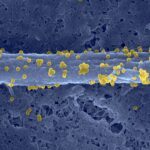Lien vers Pubmed [PMID] – 24274459
Lien DOI – 10.1111/1462-2920.12342
Environ Microbiol 2014 Feb; 16(2): 405-16
Listeria monocytogenes is ubiquitously prevalent in natural environments and is transmitted via the food chain to animals and humans, in whom it can cause life-threatening diseases. We used Multilocus Sequence Typing (MLST) of ∼2000 isolates of L. monocytogenes to investigate whether specific associations existed between clonal complexes (CCs) and the environment versus diseased hosts. Most CCs (72%) were not specific for any single source, and many have been isolated from the environment, food products, animals as well as from humans. Our results confirm that the population structure of L. monocytogenes is largely clonal and consists of four lineages (I-IV), three of which contain multiple CCs. Most CCs have remained stable for decades, but one epidemic clone (CC101) was common in the mid-1950s and very rare until recently when it may have begun to re-emerge. The historical perspective used here indicates that the central sequence types of CCs were not ancestral founders but have rather simply increased in frequency over decades.

